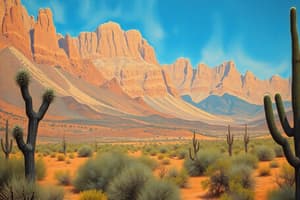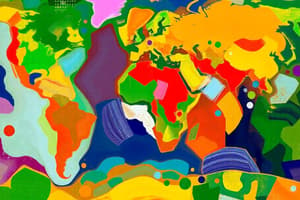Podcast
Questions and Answers
Flashcards
Ecology
Ecology
The scientific study of the interactions between organisms and their environment.
Economy of Nature
Economy of Nature
Ecology, defined as the economy of nature by Ernest Haeckel, represents the interactions and resources of living things in an environment.
Abiotic Factors (Biomes)
Abiotic Factors (Biomes)
Non-living factors influencing biomes, including nutrient distribution, climate, water availability, etc.
Hadley Cells
Hadley Cells
Signup and view all the flashcards
Biome
Biome
Signup and view all the flashcards
Global Precipitation & Temperature
Global Precipitation & Temperature
Signup and view all the flashcards
Desert Biome
Desert Biome
Signup and view all the flashcards
Aquatic Ecosystems
Aquatic Ecosystems
Signup and view all the flashcards
Gulf Stream
Gulf Stream
Signup and view all the flashcards
Earth's Axial Tilt
Earth's Axial Tilt
Signup and view all the flashcards
Ultimate Energy Source (Biosphere)
Ultimate Energy Source (Biosphere)
Signup and view all the flashcards
GPP (Gross Primary Production)
GPP (Gross Primary Production)
Signup and view all the flashcards
NPP (Net Primary Production)
NPP (Net Primary Production)
Signup and view all the flashcards
Standing Crop Biomass
Standing Crop Biomass
Signup and view all the flashcards
Tropical Biodiversity
Tropical Biodiversity
Signup and view all the flashcards
Global Terrestrial NPP
Global Terrestrial NPP
Signup and view all the flashcards
Open Ocean Productivity
Open Ocean Productivity
Signup and view all the flashcards
Carbon Sink
Carbon Sink
Signup and view all the flashcards
Stability Hypothesis
Stability Hypothesis
Signup and view all the flashcards
Trophic Level Energy Transfer
Trophic Level Energy Transfer
Signup and view all the flashcards
Ecosystem Dynamics
Ecosystem Dynamics
Signup and view all the flashcards
Ecosystem Feedback
Ecosystem Feedback
Signup and view all the flashcards
Gaia Hypothesis
Gaia Hypothesis
Signup and view all the flashcards
Ecology Definition
Ecology Definition
Signup and view all the flashcards
Ecology's Origin
Ecology's Origin
Signup and view all the flashcards
Abiotic Biome Factors
Abiotic Biome Factors
Signup and view all the flashcards
Atmospheric Circulation (Equator)
Atmospheric Circulation (Equator)
Signup and view all the flashcards
Biome Definition
Biome Definition
Signup and view all the flashcards
Global Precipitation & Temperature
Global Precipitation & Temperature
Signup and view all the flashcards
Desert Biome
Desert Biome
Signup and view all the flashcards
Aquatic Ecosystem Driver
Aquatic Ecosystem Driver
Signup and view all the flashcards
Gulf Stream Role
Gulf Stream Role
Signup and view all the flashcards
Earth's Seasonal Changes
Earth's Seasonal Changes
Signup and view all the flashcards
Biosphere's Energy Source
Biosphere's Energy Source
Signup and view all the flashcards
GPP Definition
GPP Definition
Signup and view all the flashcards
NPP Calculation
NPP Calculation
Signup and view all the flashcards
High Standing Crop Biomass
High Standing Crop Biomass
Signup and view all the flashcards
Tropical Biodiversity
Tropical Biodiversity
Signup and view all the flashcards
Global Terrestrial NPP
Global Terrestrial NPP
Signup and view all the flashcards
Open Ocean Productivity Driver
Open Ocean Productivity Driver
Signup and view all the flashcards
Carbon Sink
Carbon Sink
Signup and view all the flashcards
Stability Hypothesis
Stability Hypothesis
Signup and view all the flashcards
Trophic Level Energy Transfer
Trophic Level Energy Transfer
Signup and view all the flashcards
Ecosystem Dynamics
Ecosystem Dynamics
Signup and view all the flashcards
Ecosystem Feedback
Ecosystem Feedback
Signup and view all the flashcards
Study Notes
Ecology and Climate
- Ecology is the scientific study of interactions between organisms and their environment
- Carl Linnaeus was the first to define ecology as the "economy of nature"
- Abiotic factors impacting biomes include nutrient distribution and climate
- Hadley cells drive atmospheric circulation at the equator
- A biome is defined as the largest regional ecosystems with specific soil and climate conditions
- Global precipitation and temperature are driven by ocean currents
- A desert biome forms in areas with low precipitation and high temperatures
- Salinity is critical for defining aquatic ecosystems
- The Gulf Stream distributes heat from equatorial regions
Productivity and Biodiversity
- The ultimate energy source for the biosphere is electromagnetic radiation
- GPP stands for Gross Primary Production
- NPP (Net Primary Productivity) is calculated as GPP minus Respiration
- Tropical rainforests support the most biomass globally
- Tropical regions have high biodiversity due to stability and productivity
- The range of global terrestrial NPP is 0.1-3.2 kg C/ m²/year
Ecosystems and Dynamics
- A defining characteristic of ecosystems is that they are complex dynamic systems
- Ecosystem dynamics are driven by interactions between species and their environment
- Feedback in ecosystems relates outputs to inputs, amplifying or reducing effects
- Earth is viewed as a self-regulating superorganism within the Gaia Hypothesis
- Climate is driven by atmospheric dynamics
Predation, Parasitism, and Mutualism
- Excluding dingoes increased kangaroo populations significantly; a result of removal of predators
- Co-evolution is the simultaneous evolution of predators and prey in response to each other
- Predator-prey cycles demonstrate an evolutionary "arms race" between bats and moths
- Beneficial mutualisms are an example where both species benefit from the interaction. Both species can survive independently in non-obligate mutualisms
Invasive Species and Management
- Approximately 5,000 invasive species exist presently in the U.S.
- The Lacey Act prohibits the trade in illegally taken wildlife.
- Zebra mussels were successfully controlled
- Invasive species cost the U.S. economy billions of dollars annually.
Global Dilemmas
- Eutrophication is caused by excess nutrients in water.
- Zebra mussels significantly impact aquatic food webs in ecosystems
- "Dead zones" are characterized by low oxygen levels.
- Salinization is caused by excess salts from human activities
- Invasive species negatively impact ecosystems, often causing habitat destruction and loss of biodiversity
Multiple-Choice Quiz; Predation, Ecosystems and Global Dilemmas
- Co-evolution in predator-prey interactions involves simultaneous evolutionary adjustments of both parties in response to each other
- Elton documented the predator-prey cycles that involve lynx and hares lasting around ten years
- Skunks and ducks experiments demonstrated that removing predators does not automatically lead to increases in prey populations; some studies have indeed shown that prey survival may decrease
- Temperature and food availability control hare populations
- Parasitism results in harm or death for the host;
Ecology, Ecosystems, and Biodiversity
- Biotic factors affecting the environment include distribution of nutrients, predator-prey relationships, overall effects of climate, dissolved oxygen levels, salinity, current, and tides.
- The biosphere is made up of the atmosphere, lithosphere, and hydrosphere.
- The primary energy source powering the biosphere is the sun
- Ellen Richards was a pioneer in environmental chemistry in the late 1800s and early 1900s
- Partitioning in lizard populations is determined by feeding times, temperature, and size
- A biome encompasses all of earth's components; Atmosphere, hydrosphere, and lithosphere;
- The Keeling curve represents a long-term record of Carbon Dioxide levels.
- Habitat fragmentation from natural and/or human activities decreases biodiversity
- Eutrophication is caused by an excess of nutrients in the water.
- Salinization is caused by excess salts in the soil from improper irrigation
Studying That Suits You
Use AI to generate personalized quizzes and flashcards to suit your learning preferences.




